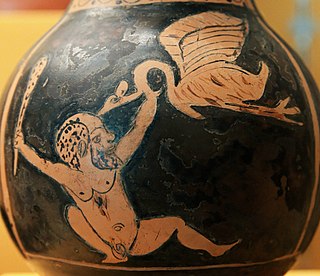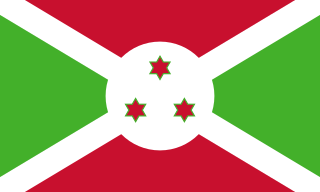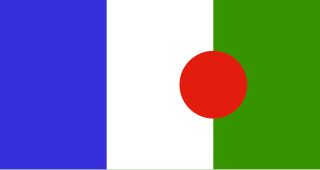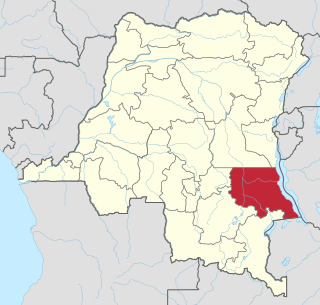Khonvoum is the supreme god and creator in the mythology of the Bambuti Pygmy people of central Africa. He is the "great hunter", god of the hunt, and carries a bow made of two snakes which appears to mortals as a rainbow. He rules the heavens and when the sun sets, he gathers pieces of the stars and throws it at the sun so that it may rise the next day in its full splendor. He contacts people by means of the mythical elephant Gor (the thunderer) or through a chameleon. [1] Khonvoum created black and white people from black and white clay and the Pygmies from red clay. For them, he also created the jungle with its lush vegetation and animal life.
In Hawaiian mythology, Kāne is considered the highest of the three major Hawaiian deities, along with Kū and Lono. He represented the god of procreation and was worshipped as ancestor of chiefs and commoners. Kāne is the creator and gives life associated with dawn, sun and sky. No human sacrifice or laborious ritual was needed in the worship of Kāne. In the Kumuhonua legend, he created Earth, bestowed upon it sea creatures, animals, plants, as well as created man and woman.

Efik mythology consists of a collection of myths narrated, sung or written down by the Efik people and passed down from generation to generation. Sources of Efik mythology include bardic poetry, art, songs, oral tradition and proverbs. Stories concerning Efik myths include creation myths, supernatural beings, mythical creatures, and warriors. Efik myths were initially told by Efik people and narrated under the moonlight. Myths, legends and historical stories are known in Efik as Mbụk while moonlight plays in Efik are known as Mbre Ọffiọñ.

Obatala is an orisha in the Yoruba mythology that was given the task to create the Earth but failed the task by being drunk on palm wine and was outshined by his little brother Oduduwa. As punishment for his negligence to an important task he was given the job to create humans beings. This was authorized by his father, Olodumare which gave Obatala the name sculptor of mankind. According to Yoruba myths, Obatala was in charge of the complexion of humans after moulding them. Those he fairly burnt ended up being the Europeans(Whites) while those he forgot in the fire due to his drunkenness ended up being the Africans(ebony). Those he forgot to burn are the present day 'albino'.
"Now Olodumare [the supreme being] once called on Obatala and told him that he would love him to assist in creating human beings that would live in the world he was about to create. This is because as he (Olodumare) said further he would not like the world he was planning to create to exist without human beings."
The Bushongo or Songora are an ethnic group from the Congo River and surrounding areas. The creator god in Bushongo mythology is called Bumba. Other names for him include M'Bombo and M'Bomba. He is said to have originally existed alone in darkness, in a universe consisting of nothing but primordial water. M'Bombo was said to appear like a gigantic man in form and white in colour. The creation took place when he vomited the sun, moon, animals and then humanity. Stephen Hawking mentioned the Boshongo creation myth in his last book, "Brief Answers to the Big Questions", as an example of one of humanity's many creation myths.
Mbuti (Bambuti) mythology is the mythology of the African Mbuti Pygmies of Congo.

In creation myths, the term "Five Suns" refers to the belief of certain Nahua cultures and Aztec peoples that the world has gone through five distinct cycles of creation and destruction, with the current era being the fifth. It is primarily derived from a combination of myths, cosmologies, and eschatological beliefs that were originally held by pre-Columbian peoples in the Mesoamerican region, including central Mexico, and it is part of a larger mythology of Fifth World or Fifth Sun beliefs.

The Mbuti people, or Bambuti, are one of several indigenous pygmy groups in the Congo region of Africa. Their languages are Central Sudanic languages and Bantu languages.

Philippine mythology is the body of stories and epics originating from, and part of, the indigenous Philippine folk religions, which include various ethnic faiths distinct from one another. Philippine mythology is incorporated from various sources, having similarities with Indonesian and Malay myths, as well as Hindu, Muslim, Shinto, Buddhist, and Christian traditions, such as the notion of heaven, hell, and the human soul. Philippine mythology attempts to explain the nature of the world through the lives and actions of heroes, deities, and mythological creatures. The majority of these myths were passed on through oral tradition, and preserved through the aid of community spiritual leaders or shamans and community elders.
Polygenism is a theory of human origins which posits the view that the human races are of different origins (polygenesis). This view is opposite to the idea of monogenism, which posits a single origin of humanity. Modern scientific views no longer favor the polygenic model, with the monogenic "Out of Africa" hypothesis and its variants being the most widely accepted models for human origins. Historically, polygenism has been used to advance racial inequality.

Snakes are a common occurrence in myths for a multitude of cultures. The Hopi people of North America viewed snakes as symbols of healing, transformation, and fertility. In other cultures snakes symbolized the umbilical cord, joining all humans to Mother Earth. The Great Goddess often had snakes as her familiars—sometimes twining around her sacred staff, as in ancient Crete—and they were worshipped as guardians of her mysteries of birth and regeneration. Although not entirely a snake, the plumed serpent, Quetzalcoatl, in Mesoamerican culture, particularly Mayan and Aztec, held a multitude of roles as a deity. He was viewed as a twin entity which embodied that of god and man and equally man and serpent, yet was closely associated with fertility. In ancient Aztec mythology, Quetzalcoatl was the son of the fertility earth goddess, Cihuacoatl, and cloud serpent and hunting god, Maxicoat. His roles took the form of everything from bringer of morning winds and bright daylight for healthy crops, to a sea god capable of bringing on great floods. As shown in the images there are images of the sky serpent with its tail in its mouth, it is believed to be a reverence to the sun, for which Quetzalcoatl was also closely linked.

The Pygmies were a tribe of diminutive humans in Greek mythology.

The following outline is provided as an overview of and topical guide to Burundi:

The Twa are a group of indigenous African Pygmy tribes.

The Great Lakes Twa, also known as Batwa, Abatwa or Ge-Sera, are a Bantu ethnic group native to the African Great Lakes region on the border of Central and East Africa. As an indigenous pygmy people, the Twa are generally assumed to be the oldest surviving population of the Great Lakes region. Current populations of Great Lakes Twa people live in the states of Rwanda, Burundi, Uganda and the eastern portion of the Democratic Republic of Congo. In 2000 they numbered approximately 80,000 people, making them a significant minority group in these countries.

The Batwa–Luba clashes were a series of clashes in the Democratic Republic of the Congo (DRC) between the Pygmy Batwa people, and the Luba people that began in 2013 and ended in 2018.

Effacer le tableau was the operational name given to the systematic extermination of the Bambuti pygmies by rebel forces in the Democratic Republic of the Congo (DRC).
Arebati is known as the god of creation or supreme god in the mythology of the Efé people of the Democratic Republic of the Congo. The deity is also worshipped by the Mbuti people, but under a different name, which is Baatsi. In other African Pygmies' mythologies, Arebati and Tore are synonymous to one another, while in others, Tore is a forest god while Arebati is a lunar god.